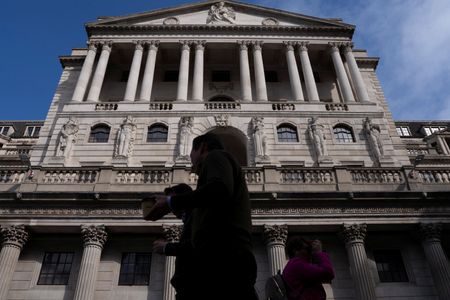By Lisa Pauline Mattackal
(Reuters) -It’s late to the sell-USA party. But bitcoin is finally reclaiming its place as a big alternative for investors spooked by President Donald Trump’s trade war and keen to dump U.S. stocks, Treasuries and the dollar.
After an initial tumble to its lowest levels this year soon after Trump announced his Liberation Day tariffs on April 2, the notoriously volatile bitcoin has slowly clawed back ground. It managed to outperform stock markets in 10 out of 17 sessions in that period, VanEck data shows.
The world’s top and original cryptocurrency is now a whisker away from the $100,000 mark last seen three months ago, after a 15% rise in April alone.
By comparison, the S&P 500 slipped around 0.8% in April, the tech-focused Nasdaq Composite eked out 0.8% gains last month, while the U.S. dollar index fell over 4%.
“The most recent price action may have begun to validate the view that Bitcoin is not just the 501st company in the SPX,” analysts at research firm Block Scholes said.
Bitcoin is up 33% from its April low in a surprising turn for the cryptocurrency, given how closely it has mimicked the performance of equity markets in periods of market turmoil- particularly the tech sector – over the past few years.
Correlations between bitcoin and other asset classes have also shifted, according to Block Scholes, and bitcoin is the most inversely correlated to the steepness of the Treasury yield curve in over two years.
“Investors are really starting to respond to (bitcoin) as a potential diversifier,” said Ben McMillan, chief investment officer at IDX Advisors.
Bitcoin has even outperformed gold’s 11% rise since April 2, despite the safe-haven metal’s surge to record highs. Measures of bitcoin’s expected volatility have dropped to 18-month lows, as per Block Scholes.
“The damage has been done in terms of trust towards the U.S. and dollar assets … but you can’t (diversify) overnight,” said Martin Leinweber, director of digital asset research & strategy at MarketVector Indexes.
“What kind of neutral assets do you have? Underlying that is really a supportive shift towards bitcoin and crypto.”
Investors have also turned more bullish on digital asset-focused investment products, with roughly $5.5 billion over the last three weeks flowing into those funds, as per CoinShares data, including $1.8 billion in the week through May 3 for bitcoin products.
If changing tariff policies continue to drive a move away from U.S. assets, bitcoin could find its next leg higher, Geoff Kendrick, global head of digital asset research at Standard Chartered Bank said in a note to clients.
“We expect a strategic asset reallocation away from U.S. assets to trigger the next sharp upswing in bitcoin in the coming months,” Kendrick said, adding he sees bitcoin hitting a new record high of around $120,000 in the second quarter of 2025.
TOO MUCH, TOO SOON
It’s far too early, however, to say bitcoin has severed its ties with macroeconomic developments.
Bitcoin’s 30-day correlation to the S&P 500 briefly dipped to 0.45 in early April but has crept back up to 0.87, as per LSEG data, where 1 indicates they are moving in lockstep.
And it still remains some ways away from its January record high.
“I think we’ll inevitably see periods going forward where bitcoin’s correlation (to risk assets) rises again,” said IDX Advisors’ McMillan.
“But the key point is, it is starting to take on trading characteristics of its own.”
(Reporting by Lisa Mattackal in Bengaluru; Editing by Vidya Ranganathan and Alexandra Hudson)










